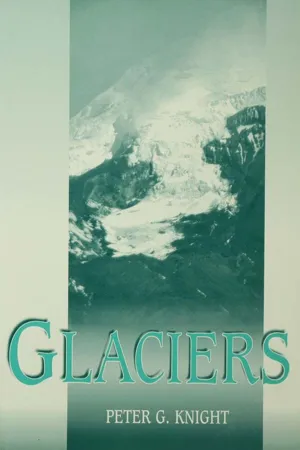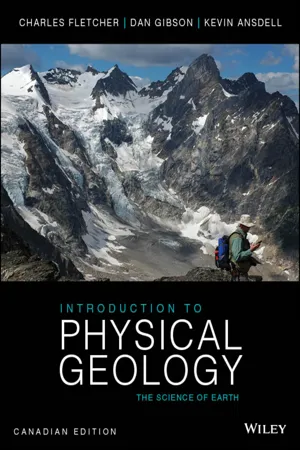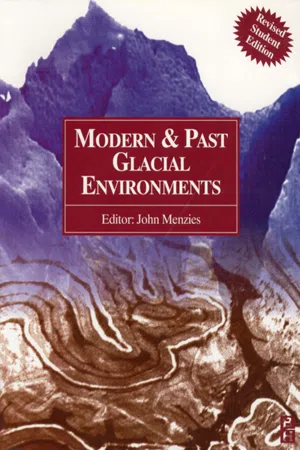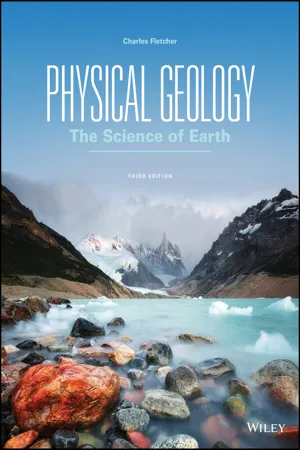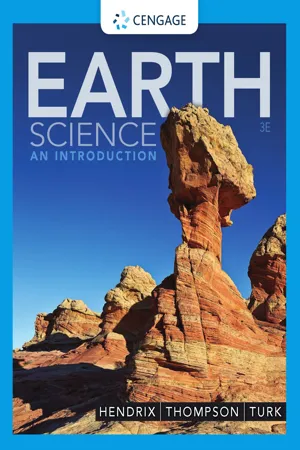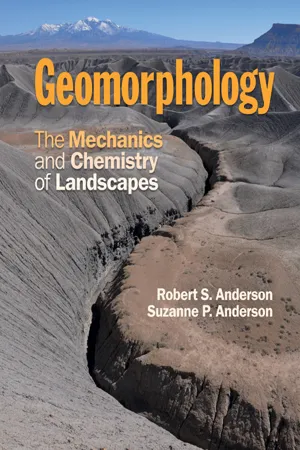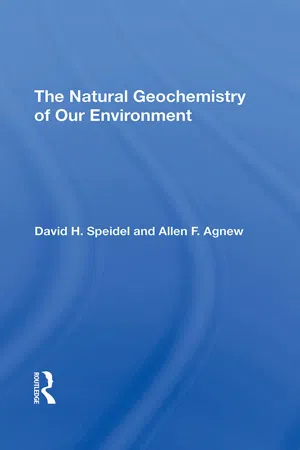Geography
Glacial Movement
Glacial movement refers to the slow flow of ice within a glacier. This movement is driven by the force of gravity and the internal deformation of the ice. Glaciers can move in various ways, including sliding along their base and flowing like a viscous fluid. The study of glacial movement is important for understanding how glaciers shape the landscape and contribute to processes like erosion and deposition.
Written by Perlego with AI-assistance
Related key terms
1 of 5
9 Key excerpts on "Glacial Movement"
- 7 Movement of Glaciers
7.1 Glacier Motion
The fact that glaciers move is critical to the hydrological cycle, to the functioning of the ocean/atmosphere system, and to all the geological and geomorphological phenomena that arise from glaciation. In all glaciers ice moves from the accumulation area to the ablation area, the motion supplied by input of fresh ice in the accumulation area and drained ultimately by loss of ice in the ablation area. This movement of ice through the glacier is achieved by a variety of mechanisms, which combine to different degrees in different circumstances, so glaciers can behave in a range of different ways. This chapter focuses on the nature of glacier motion and the mechanisms by which driving forces are converted to movement. We are concerned here primarily with horizontal motion. Aspects of the vertical movement of ice are considered in Chapter 5 (regarding basal ice) and Chapter 11 (regarding ice cores).Glaciers move at a wide range of speeds. In surging glaciers, speeds of up to 65 m d-1 have been recorded over short periods. The fastest moving non-surge glaciers include Jakobshavn Isbrae, which maintains continuous speeds of up to 7 km a-1 (≈19 m d-1 ) near its snout (Echelmeyer and Harrison, 1990 ). More typical speeds for glaciers are of the order of centimetres per day, or metres per year. Table 7.1 illustrates some of the range of glacier velocities that have been measured. Most glaciers also exhibit substantial temporal variations in movement. Surging glaciers alternate periodically between slow and fast flow, and many non-surging glaciers do the same, to a lesser extent, on a seasonal basis. Individual glaciers also show different rates of movement in different parts of their area, in response to local mass flux and dynamic controls.7.2 Mechanisms of Movement
7.2.1 Types of Motion and Driving Forces
Movement occurs by different mechanisms in different locations within a glacier. Movement can occur within the ice, or at the boundary between the ice and the substrate, or within the substrate itself. Internal movement is accomplished by creep and by thrusting. Movement at the bed is accomplished by sliding, by regelation and by enhanced basal creep. Movement within the substrate is accomplished by deformation of the subglacial material, and this material can itself slide over a rigid underlayer. These mechanisms might not all operate at a particular glacier, and operate in different proportions in different situations, but can be illustrated schematically as in Figure 7.1 - No longer available |Learn more
- (Author)
- 2014(Publication Date)
- Learning Press(Publisher)
____________________ WORLD TECHNOLOGIES ____________________ Chapter-2 Motion of Glaciers The Nadelhorn Glacier above Saas-Fee, Valais, Switzerland Glaciers move, or flow, downhill due to the internal deformation of ice and gravity. Ice behaves like an easily breaking solid until its thickness exceeds about 50 meters (160 ft). The pressure on ice deeper than that depth causes plastic flow. At the molecular level, ice consists of stacked layers of molecules with relatively weak bonds between the layers. When the stress of the layer above exceeds the inter-layer binding strength, it moves faster than the layer below. ____________________ WORLD TECHNOLOGIES ____________________ Another type of movement is through basal sliding. In this process, the glacier slides over the terrain on which it sits, lubricated by the presence of liquid water. As the pressure increases toward the base of the glacier, the melting point of water decreases, and the ice melts. Friction between ice and rock and geothermal heat from the Earth's interior also contribute to melting. This type of movement is dominant in temperate, or warm-based glaciers. The geothermal heat flux becomes more important the thicker a glacier becomes. The rate of movement is dependent on the underlying slope, amongst many other factors. Fracture zone and cracks Ice cracks in the Titlis Glacier ____________________ WORLD TECHNOLOGIES ____________________ Signs warning of the hazards of a glacier in New Zealand The top 50 meters of the glacier, being under less pressure, are more rigid; this section is known as the fracture zone , and mostly moves as a single unit, over the plastic-like flow of the lower section. When the glacier moves through irregular terrain, cracks up to 50 meters deep form in the fracture zone. The lower layers of glacial ice flow and deform plastically under the pressure, allowing the glacier as a whole to move slowly like a viscous fluid. - eBook - PDF
- Charles Fletcher, Dan Gibson, Kevin Ansdell(Authors)
- 2014(Publication Date)
- Wiley(Publisher)
As the ice moves over uneven terrain, portions of the glacier compress and extend, causing changes in the surface topography of the glacier as well as differences in the internal movement of the ice. Glacial sediments are eroded from bedrock through plucking and abrasion. They may fall from surrounding valley walls onto the ice and be carried to the front of the glacier by the internal movement of ice into the zone of wastage. When the ice retreats, the resulting deposit is known as glacial drift. List and describe the ways that glaciers move and deposit sediment. 17-4 Glacial Landforms Are Widespread and Attest to Past Episodes of Glaciation • 461 Kettle lake Terminal moraine Retreating glacier Ground moraine Outwash plain Kame Drumlin field Esker Wayne Lynch/Age Fotostock America, Inc. Carlyn Iverson/Science Source E.R. Degginger/Science Photo Library Marvin Dembinsky/Photo Associates/Alamy FIGURE 17.14 (a) Glacial till is unstratified and unsorted sediment that has been deposited directly by wasting ice. (b) Moraines are deposits of till formerly in direct contact with ice. This photo of a glacier on Bylot Island, Nunavut, shows a terminal moraine and lateral moraine. (c) When valley glaciers coalesce, like those shown from the Kaskawulsh Glacier in the St. Elias range of Yukon Territory, their lateral and medial moraines come together to form strips of sediment (till) on the surface of the ice. It is common to find glaciated landforms composing kame and kettle topography where kettle lakes and kame deposits are spread across the land. Eskers are long, sinuous ridges of sand and gravel deposited by streams that former- ly ran under or within a glacier. As the ice melts, the channel deposits are lowered to the ground and form a ridge known as an esker. The land surface beneath a moving continen- tal ice sheet can be moulded into smooth, elongated forms called drumlins. - eBook - PDF
Modern and Past Glacial Environments
Revised Student Edition
- John Menzies(Author)
- 2002(Publication Date)
- Butterworth-Heinemann(Publisher)
Glaciers frozen to their substrates are incapable of significant geo-morphic work and may even have reduced erosion rates compared with neighbouring ice-free land. Indeed, doubt exists as to whether warm-based glaciers necessarily erode and transport more material than non-glacial processes in landscapes of similar relief and precipitation (Hicks et al. , 1990). Never-theless, processes of glacial transportation have played a major role in shaping landscapes, in moving vast supplies of sediment both on land and in the oceans and in the genesis and maturation of many glacial land- and bed-forms. The understanding of the principles of drift exploration and in mining placer deposits (Menzies, 1996, chapters 15 and 16) in the establishment of the geotechnical character of glacial sediments and in the decisions concerning the suita-bility or otherwise of landfill sites for the disposal of toxic and other waste products hinges upon the impact and influence of glacial transport processes (De Mulder and Hageman, 1989). 6.2. ICE PROPERTIES AFFECTING SEDIMENT TRANSPORT Glaciers are commonly likened to ‘rivers of ice’. Such a comparison could not be further from the truth when the mechanics of flow and the nature of sediment transport are considered. An understanding of glacial transport depends on examining those physical prop-erties of ice that have a direct bearing on how rock particles are entrained and transported. Three proper-ties are important in this context: ice temperature, density and viscosity. 6.2.1. Temperature Within any ice mass, ice temperature varies over both time and space (Chapter 3). Ice at the base of many ice masses is at or close to the pressure melting point. Pressure melting occurs over large areas of glacier beds where overburden pressures are high (Fig. 6.1) and in localized zones in response to pressure variations caused by substrate irregularities. - eBook - PDF
Physical Geology
The Science of Earth
- Charles Fletcher(Author)
- 2017(Publication Date)
- Wiley(Publisher)
459 CHAPTER 15 CHAPTER OUTLINE 15.1 A glacier is a river of ice. 15.2 Glaciers are found in a wide diversity of forms and environments. 15.3 Ice moves through the interior of a glacier as if on a one-way conveyor belt. 15.4 Glacial landforms are widespread and attest to past episodes of glaciation. 15.5 The majority of glaciers and other ice features are retreating in reaction to global warming. 15.6 The ratio of oxygen isotopes in glacial ice and deep-sea sediments provides a proxy for global climate history. 15.7 Earth’s recent history has been characterized by alternating cycles of ice ages and interglacials. 15.8 During the last interglacial, climate was warmer and sea level was higher than at present. 15.9 Paleoclimate is influenced by the timing and location of sunlight reaching Earth. 15.10 Together, orbital forcing and climate feedbacks produced the paleoclimate. Glaciers and Paleoclimatology Mira/Alamy Glaciers are rivers of ice that sculpt the land surface by eroding the crust and depositing sediments as they move. Almost every mountain system in the world has evidence of past glaciation. What would evidence of past glaciation look like? LEARNING OBJECTIVES 15.1 Describe glaciers and where they occur today. 15.2 List and define the various types of glaciers. 15.3 Describe how ice moves in a glacier and explain how this movement affects the front of the glacier. 15.4 Compare and contrast depositional and erosional features formed by glaciers. 15.5 Describe the response of various ice environments to global warming. 15.6 Describe how oxygen isotopes provide a proxy for global climate history. 15.7 Define marine isotopic stages and explain what they indicate. 15.8 List characteristics of the last interglacial that are relevant to understanding the consequences of modern global warming. 15.9 Define the Earth-Sun orbital parameters. 15.10 Describe climate feedbacks and give examples. - eBook - PDF
Earth Science
An Introduction
- Mark Hendrix, Graham Thompson, Mark Hendrix(Authors)
- 2020(Publication Date)
- Cengage Learning EMEA(Publisher)
Moving glacial ice commonly will dislodge and pluck individual boulders from such frac- tured bedrock. The plucked boulders are then transported downslope as clasts either within or at the base of the glacier (●FIGURE 13.8). Ice is viscous enough to pick up and carry particles of all sizes, from house-sized boulders to clay-sized grains. Thus, glaciers erode and transport huge quantities of rock and sediment. Ice itself is not abrasive to bedrock, because it is too soft. However, rocks embedded in the ice scrape across bedrock, gouging deep, parallel grooves and scratches called glacial striations (●FIGURE 13.8B). When glaciers melt and striated bedrock is exposed, the markings show the direction of ice movement. Geologists measure the orientation of glacial striations and use them to map the flow directions of ancient glaciers. winter, is called the zone of ablation. When the snow melts, a surface of old, hard glacial ice is left behind. The equilib- rium altitude line, or ELA, is the boundary between the zone of accumulation and the zone of ablation. The ELA shifts up and down the glacier from year to year, depending on weather. Ice exists in the zone of ablation because the gla- cier flows downward from the accumulation area. Further down the valley, the rate of glacial flow cannot keep pace with melting, so the glacier ends at its terminus. Glaciers grow and shrink. For example, the zone of accumulation in an alpine glacier will grow thicker and the glacier’s ELA will descend to a lower elevation if annual snowfall increases and more firn survives the summer with- out completely melting. At first the glacial terminus may remain stable, but eventually it will advance farther down the valley. The lag time between a change in climate and the advance of an alpine glacier may range from a few years to several decades, depending on the size of the glacier, its rate of movement, and the magnitude of the climate change. - eBook - PDF
Geomorphology
The Mechanics and Chemistry of Landscapes
- Robert S. Anderson, Suzanne P. Anderson(Authors)
- 2010(Publication Date)
- Cambridge University Press(Publisher)
Ice deformation 225 of ice down valleys, some large segment of the glacier population has yet another process to allow transport of ice down valleys. If the ice near the bed of the glacier is near the melting point, the ice can slide across the bed. As it is only by this mechanism that the bed of the glacier can be modified by the motion of ice above it, it is sliding that is the focus of glacial geologic studies. Sliding of the ice is permitted by a special property of water: high pressure promotes melting. A corollary to this is that the high pressure phase of water is ice, its solid phase. This makes ice very different from, say, quartz or olivine, whose melted liquid state is lighter than their solid, and for which higher pressure therefore promotes the change of phase from the solid to the liquid. This can be seen in the phase diagram for the water system we first introduced in Figure 1.2 . The negative slope (of –0.0074 C/bar, or 7.4 10 –8 C/Pa) on the P–T plot, separating the water and ice phases, is what differentiates water from most other substances. Consider the conditions at the bed of a temperate glacier, which by definition it is at its freezing point throughout (meaning at all points the temperature lies along the phase boundary, declining at 0.0074 C/11 m of depth). The glacier rests on a sloping valley floor that is not perfectly smooth, but has bumps and swales in it depicted in Figure 8.14 . We probably would all agree that the ice is not accel-erating (changing its velocity) very much. If it is doing so, it is doing so very slowly, meaning that the accel-erations are very slight. This means, through Newton’s law F ¼ ma , that the forces on the ice are essentially balanced. There is also heat arriving at the base of the glacier from beneath the glacier, at a rate sufficient to melt about 5 cm of ice per year. - eBook - PDF
- David H Speidel, Allen F. Agnew(Authors)
- 2019(Publication Date)
- Routledge(Publisher)
Introduction 3 Geochemical Movement This worltJ tJkmg its /Jfllh flliDtm&es. -Thomas More The movement of elements takes place physically, as mineral grains and/or rock fragments, or chemically, in solutions. Generally the same elements oc-cur in both types of movement in varying proportions. Some of the well-known dispersion mechanisms are given in Table 3-1. Rapid mass movement of material such as occurs in mud slides or rock slides, while locally important, does not contribute a major portion of total geochemical movement. Slow mass movement, such as soil creep in response to gravitational forces or seasonal fluctuations, transports tremendous amounts of material, but for only short distances. It is the transportation of fluids such as streams, wind, and ice that provides most of the movement of interest to the environmental geochemist. Some of this transport, such as capillary movement of soil water and stem flow, discussed in the previous chapter (1), moves elements that are necessary for biological processes. Unfortunately, however, only limited estimates of those quantities are available. For example, the total tree-stem load can exceed the total precipitation runoff from surface water and ground water combined (2). In this chapter we shall concentrate on transportation of elements by streams, ice, and wind. Transport by Streams Dissolved Load Evaluation of the dissolved load can be made by multiplying the stream discharge (39, 700 km 3 /yr) by the dissolved concentration (or chemical com-position) of the stream. The total amount is thus a combined function of the concentration of dissolved ions (salinity) and the amount of discharge. For ex-ample, a river with a salinity of 5 ppm and a discharge of 40 km'/yr will 37 TABLE 3-1 Geochemical Movement Type and Agent A. Particle movement !.Moving Water 2.Glacial Ice 3.Wind 4 .Mass Movement B. - eBook - PDF
- Alan F. Arbogast(Author)
- 2017(Publication Date)
- Wiley(Publisher)
Geo Media Depositional Glacial Landforms Like many other Earth processes, the formation of glacial land- forms can be better understood when visualized in animated form. To do so, go to the Geo Media Library and select Depositional Glacial Landforms. This animation illustrates the way moving and melting ice shapes the landscape. It also contains a nice video of glaciers in Peru. After you complete the interactivity, be sure to answer the questions at the end to test your understanding. Key Concepts to Remember About Glacial Deposition and Resulting Landforms 1. Two primary kinds of glacial deposits occur: till and outwash. Glacial till is deposited in direct contact with the ice, whereas glacial outwash accumulates through meltwater streams flowing in front of the ice. 2. Glacial till is relatively unsorted and accumulates either as basal (lodgement) till smeared under the bottom of the glacier or as ablation till laid down as the ice melts. 3. A distinctive depositional landform created by glaciers is a moraine (end, lateral, or medial), which is a ridge of till that forms when the ice front or margin is in one place for a relatively long period of time. Drumlins are streamlined till landforms created by the weight and pressure of the overlying flowing ice. 4. Glacial outwash is relatively well sorted because it is deposited by flowing meltwater in front of the ice. The associated streams are typically braided and create a broad, flat surface known as an outwash plain. Sometimes glacial outwash buries a block of ice that broke off the front of a receding glacier. When this ice block subsequently melts, it forms a water-filled depression called a kettle lake. 5. Kames and eskers are distinctive meltwater landforms. A kame is an irregularly shaped hill that essentially consists of an alluvial fan or a deltaic deposit that forms in contact with the ice.
Index pages curate the most relevant extracts from our library of academic textbooks. They’ve been created using an in-house natural language model (NLM), each adding context and meaning to key research topics.
